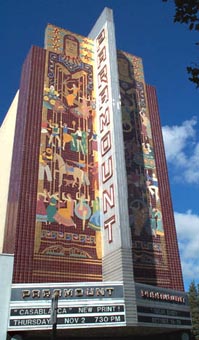By Dick Meister Listen to Jim Riggs  If you can get to the Paramount Theatre in Oakland, get there. Movies, jazz or classical music concerts, ballet, variety shows, whatever, it doesn't matter. The building is what's most important — very important. It is one of the Bay Area's, one of the country's, one of the world's truly great works of art.
If you can get to the Paramount Theatre in Oakland, get there. Movies, jazz or classical music concerts, ballet, variety shows, whatever, it doesn't matter. The building is what's most important — very important. It is one of the Bay Area's, one of the country's, one of the world's truly great works of art.In galleries and museums, you stand back and look at art on display. You are on the outside looking in. At the Paramount, you are in the midst of the art. You are surrounded by it. You are on the inside. The art is in effect looking at you. The walls, the ceilings, the floors, the light fixtures and other furnishings, all are works of art by themselves. It's stunning, the finest remaining example of Art Deco design anywhere. The carpets covering every inch of floor space carry an intricate, bright multi-colored design. The walls in the lobby, on the second floor landing at the head of a broad, sweeping staircase and inside the auditorium itself are covered, every foot, every inch, with sculptured golden bas relief panels and brilliantly colored murals. The metal outlines of figures cover the ceiling, endlessly fascinating, endlessly drawing your attention. What first appears to be just a swirl of metal suddenly becomes a figure. Uniquely patterned draperies and curtains hang everywhere. The couches in the second floor lobby have similarly patterned upholstery. Even the rest rooms carry out the Art Deco theme. Up front is a Mighty Wurlitzer organ, used for pre-movie concerts and, when a silent film is playing, to accompany the movie. There's nothing so grand as listening to master organist Jim Riggs while contemplating the marvelous art above you, to your left, to the right, and below. The exterior is also an Art Deco marvel, featuring beautifully designed mosaic tile. San Francisco Chronicle columnist Jon Carroll got it right. He called the Paramount "a splendid example of ornate rococo, gaudy, let's-go-nuts-in-public decorative art fully and lovingly restored and ornamental as all get-out." The theater was indeed lovingly restored to exactly how it was when it opened in 1931 as one of the nation's premier movie palaces. It was designed by Timothy Pfluger, the same great architect who designed such other celebrated buildings as the Castro Theater and several other 1930s film palaces in San Francisco, the Medical and Dental Building at 450 Sutter in the city, the I. Magnin store on Union Square and the Pacific Coast Stock Exchange. The Great Depression did in the Paramount, which finally closed in 1970 after many years of neglect. The Oakland Symphony, the City of Oakland and numerous private donors stepped in to buy the building and restore it in 1973. Two years later, the city took over full ownership and since then has kept it in beautiful condition. Just dare put your feet up on the back of a seat and an usher will come running to let you know, politely but firmly, that that's definitely a no-no — as it damn well should be. You can — and should — take a guided tour. You can do that on the first and third Saturdays of any month, no reservations needed, cameras allowed. The two hour tour leaves at 10 a.m. from the box office entrance on 21st Street near Broadway in Oakland. It's a mere $5 per person. Kids on the tour must be at least 10 and accompanied by adults. The best way to get to the Paramount is via the Bay Area Rapid Transit system. The theater is just a half-block from BART's 19th Street Oakland station. |
